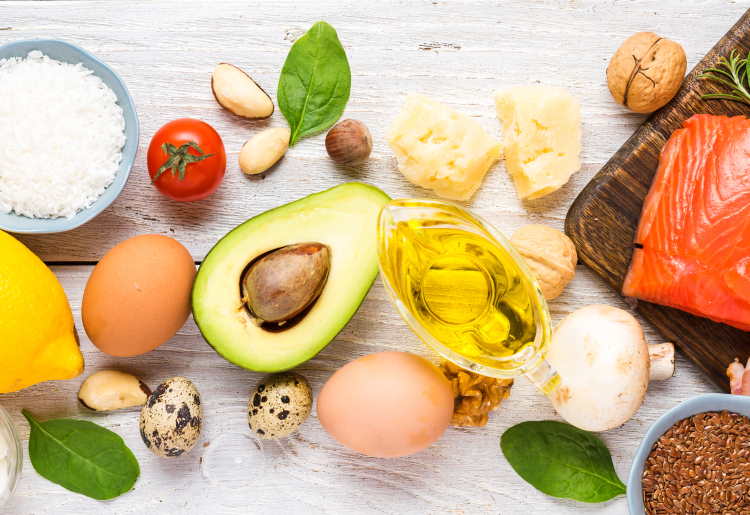When this happens, your body becomes really efficient at burning fat, which also causes massive reductions in blood sugar and insulin levels. This has numerous health benefits, making this diet unique among low-carb diet plans. There are different ketogenic diets, ranging from only low-carb to rebooting with higher-carb refeeds or eating carbs but only around exercise. If you’re ready to try a keto diet, talk to a nutritionist or find a diet meal plan that will guide you to a plan that works best for your lifestyle.
The keto diet is excellent at helping people lose lots of weight, without having to count calories, or be hungry. One study found that people on keto diets lost 2.2 times the weight of low-cal, low-fat diets and dramatically reduced their risk of heart disease.
What Does a Keto Diet Entail?
When it comes to following a Keto diet there are lots of options. Generally speaking though, here is a list of foods to eat and avoid in your daily diet.
A Sample Keto Daily Diet
Breakfast
Option 1: Bacon, eggs, and tomatoes
Option 2: Full-fat milkshake with peanut butter
Option 3: Full-fat yogurt with nuts
Lunch
Option 1: Chicken salad with tomatoes and kale
Option 2: Nuts and celery sticks with guacamole and almond butter
Option 3: Ham and cheese slices with nuts
Dinner
Option 1: Meatballs and salad
Option 2: Beef stir fry
Option 3: White fish, eggs, and spinach
Snacks
Cheese, nuts, hard boiled eggs, milkshakes, full-fat yogurt, 90% dark chocolate
Why Use a Keto Diet?
A ketogenic diet has been proven to reduce weight, lowering the risk of obesity. Since the 1960s, it’s been used as one of the primary obesity treatments. Interestingly, keto diets were originally used for epilepsy patients and have been proven to work as well as medication for some people, reducing seizures. It’s also been proven to combat diabetes, polycystic ovarian syndrome, acne, neurological diseases, cancers, and respiratory and cardiovascular diseases.
As your body becomes starved for carbs, it enters into a metabolic state called ketosis, turning fat into ketones, which are molecules supplying energy to your brain. The increase in ketones combined with the lowered insulin levels is what gives this diet its many health benefits.
Only short-term results have been studied comprehensively. Some nutritionists have criticism for the high amount of saturated fats and note that this diet is associated with an increase in “bad” cholesterol, which is also linked to heart disease.
The number one advantage of a keto diet is weight loss and reduced appetite, which occurs because Ketones suppress ghrelin, the hunger hormone. It can reduce inflammation and curb cravings because the foods you’ll be eating help you stay full longer. If you’re struggling with the health risks of obesity or want a short-term diet to lose weight for a special occasion, Keto can definitely help you shed that weight. If you’re looking for a long term solution that’s not focused around weight loss, speak to a nutritionist and follow a well rounded diet plan designed for your specific health needs.
Keto Diet Tips
The Keto diet is super simple: eat mostly healthy fats, and almost no carbs. It’s recommended that you eat no more than 20-50 grams of carbs per day, which is about one banana. Choose meat, fish, eggs, some vegetables, and good fats. There are several types of keto diets, each one with its own advantages and disadvantages.
Here’s what you should know:
- Standard Keto Diet: as few as 20-50 grams of net carbs per day
- Cyclical Keto Diet: high-fat, low carb diet for 5 or 6 days out of the week. Day 7 is a carb refeed day to boost your energy levels.
- Targeted Keto: similar to the standard keto diet, this allows for extra carbs right before a high-intensity workout, boosting your performance and returning to ketosis when you’re done exercising.
- Dirty Keto: the same breakdown as a standard keto diet, but it doesn’t have to be healthy fats, so enjoy your fast-food cheeseburger (without the bun).
- Moderate Keto: high fat diet with 150-200 net carbs per day. This is sometimes an easier plan for women, who can find that restricting carbs interferes with hormone functioning. Also, some athletes find that they don’t have enough energy on a standard keto diet.
Check with a nutritionist or doctor before making any drastic changes to your diet. Try your preferred method for keto and take it slowly. Pay attention to your body. If you’re hungry, weak, or otherwise unwell, consider switching plans. Track your carbs and forget about calories; this diet is all about proportions.
The First Step?
It can take up to a week for your body to enter ketosis, but once you’re there, you’ll have steady lasting energy, more focus and a reduced appetite. Keep track of how your feel, drink plenty of water and electrolytes, and count your carbs. If a drastic reduction in carbs isn’t for you, consider cutting back on carbs or trying one of the more limited keto diets. A keto diet can help you burn fat, reduce calorie intake, and increase feelings of fullness without the calorie-counting that’s involved in popular weight-loss diets. It can help reduce high blood pressure, obesity, and high blood sugars. Keto diets are best used short-term to lose fat, reduce the risk of obesity and improve overall health. Look into a keto diet plan that’s right for your lifestyle, and enjoy your avocados, high-fat dairy, and tender steaks.
